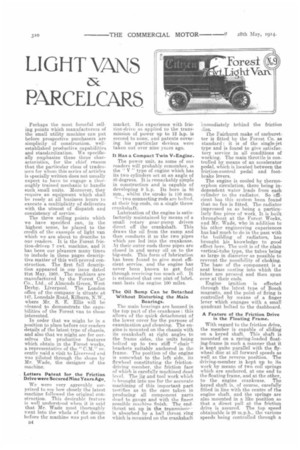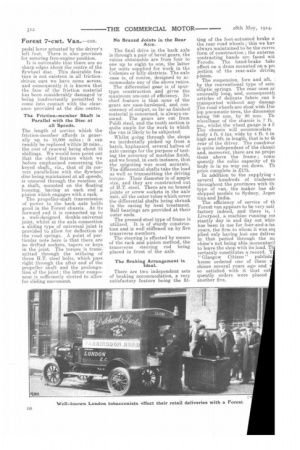LIGHT VANS PARCELCARS
Page 18

Page 20

If you've noticed an error in this article please click here to report it so we can fix it.
Perhaps the most forceful selling points which manufacturers of the small utility machine can put before prospective purchasers are simplicity of construction, wellestablished productive capabilities and standardization. We specifically emphasize these three characteristics, for the chief reason that the particular class of tradesmen for whom this series of articles is specially written does not usually expect to have to engage a thoroughly trained mechanic to handle such small units. Moreover, they require an equipment which shall be ready at all business hours to execute a multiplicity of deliveries with the utmost of dispatch and consistency of service.
The three selling points which we have specified can, in the highest sense, be placed to the credit of the example of light van which we are about to describe to our readers. It is the Forest friction-driven 7 cwt. machine, and it has been our pleasure many times to include in these pages descriptive matter of this well-proved construction. The first full description appeared in our issue dated 21st May, 1908. The machines are manufactured by the Forest Car Co., Ltd.. of Almonds Green, West Derby, Liverpool. The London office of the company is situate at 147, Lonsdale Road, Kilburn, NAV., where Mr. S. E. Ellis will be nleased to demonstrate the capabilities of the Forest van to those interested.
In order that we might be in a position to place before our readers details of the latest type of chassis, and also that we might see for ourselves the productive features which obtain in the Forest works, a representative of the "CM." recentlynaid a visit to Livernool and was piloted through the shops by Mr. Wade, the designer of the machine.
Letters Patent for the Friction Drive were Secured Nine Years Ago,
We were very agreeably surprised to see how closely the latest machine followed the original construction. This desirable feature is well understood when it is said that Mr. Wade most thoroughly went into the whole of the design before the machine was put on the D4
market. His experience with friotion-drive as applied to the transmission of power up to 12 lap. is second to none, and patents covering his particular devices were taken out over nine years ago.
It Has a Compact Twin V-Engine.
The power unit, as some of our readers will probably remember, is the " V " type of engine which has its two cylinders set at an angle of 40 degrees. It is remarkably simple in construction and is capable of developing 9 h.p. Its bore is 85 mm., whilst the stroke is 110 rem.
two connecting rods are bolted. at their big-ends, on a single throw crankshaft.
Lubrication of the engine is satisfactorily maintained by means of a small rotary gear-pump driven direct off the crankshaft. This draws the oil from the sump and then conducts it to the two pipes which are led into the crankcase. At their outer ends these pipes are closed in and spray oil on to the big-ends. This form of lubrication has been found to give most efficient service, and the engine has never been known to get foul through receiving too much oil. It is estimated that one pint of lubricant lasts the engine 100 miles.
The Oil Sump Can be Detached Without Disturbing the Main Bearings.
The main bearings are housed in the top part of the crankcase : this allows of the quick detachment of the lower cover for the purpose of examination and cleaning. The engine is mounted on the chassis with its crankshaft at right angles to the frame sides, the units being bolted up to two stiff " chair " brackets suitably anchored in the frame. The position of the engine is somewhat to the left side, its flywheel constituting the frictiondriving member, the friction fame of which is carefully machined deed level. The jig and tool work which is brought into use for the accurate machining of this important part testifies as to the care taken in producing all component parts dead to gauge and with the finest possible machine finish. The endthrust sets up in the transmissiris absorbed hy a ball thrust ring which is mounted on the crankshaft
immediately behind the friction The Fairhurst make of carburetter is fitted by the Forest Co. as standard : it is of the single-jet type and is found to give satisfactory service in all conditions of working. The main throttle is controlled by means of an accelerator pedal, which is located between the friction-control pedal and footbrake levers.
The engine is cooled by therinosyphon circulation, there being independent water leads from each cylinder to the radiator. So efficient has this system been found that no fan is fitted. The radiator impressed us as being a particularly fine piece of work. It is built throughout at the Forest Works, and Mr. Wade, who in addition to his other engineering experiences has had much to do in the past with the building of radiators, has brought his knowledge to good effect here. The unit is of the plain vertical-tube type, the tubes being as large in diameter as possible to Prevent the possibility of choking. The base of the component is a neat brass casting into which the tubes are pressed and then spun over at their ends.
Engine ignition is effected through the latest type of Bosch magneto, and the point of firing is controlled by means of a finger lever which engages with a small quadrant bolted to the dashboard.
A Feature of the Friction Drive is the Floating Frame.
With regard to the friction drive, the member is capable of sliding on a keyed shaft. This shaft is mounted on a spring-loaded floating-frame in such a manner that it is kept quite parallel with the flywheel disc at all forward speeds as well as the reverse position. The driving-member is kept up to its work by means of two coil springs which are anchored, at one end to the floating frame, and at the other, to the engine crankcase. The keyed shaft is, of course, carefully fitted in line with the centre of the engine shaft. and the springs are also mounted in a like position so that a direct pull at the friction drive is assured. The top speed obtainable is 26 m.p.h., the various speeds being controlled through a
pedal lever actuated by the driver's left foot. There is aho provision for securing free-engine position. It is noticeable that there are no sharp edges about the centre of the flywheel disc. This desirable feature is not existent in all frictiondriven cars we have come across, and consequently it is known that the face of the friction material has been considerably damaged by being inadvertently permitted to come into contact with the clearance provided at the disc centre.
The Friction-member Shaft is Parallel with the Disc at all Speeds.
The length of service which the friction-member affords is generally up to 10,000 miles ; it can readily be replaced within 20 mins., the cost of renewal being about 15 shillings. We would here point out that the chief feature which we before emphasized concerning the keyed shaft., viz,, that of its correct parallelism with the flywheel disc being maintained at all speeds, is ensured through the rotation of a shaft, mounted on the floating housing, having at each end a pinion which engages with a rack. The propeller-shaft transmission of power to the back axle holds good in the Forest chassis. At its forward end it is connected up to a well-designed double-universal joint, whilst at the axle connection a sliding type of universal joint is provided to allow for deflection of the road springs. A point of particular note here is that there are no drifted sockets, tapers or keys in the joint. The torque is transmitted through the utilizing of three H.T. steel bolts, which pass right through the after end of the propeller shaft and the prolongation of the joint ; the latter component is sufficiently slotted to allow for sliding movement.
No Brazed Joints in the Rear
Axle.
The final drive in the back axle is through a pair of bevel gears, the ratios obtainable are from four to one up to eight to one, the latter for units supplied for work in the Colonies or hilly districts. The axle case is, of course, designed to ac commodate any of the above ratios. The differential gear is of spurtype construction and gives the maximum amount of efficiency. Its chief feature is that none of the gears are case-hardened, and consistency of output, so far as finished material is concerned, is always ensured. The gears are cut from Poldi steel, and the tooth section is quite ample for the work to which the van is likely to be subjected.
Whilst going through the shops we incidentally picked up from a batch, haphazard, several halves of axle casings for the purpose of testing the accuracy of machine finish, and we found, in each instance, that the spigoting was most accurate. The differential shafts take the load as well as transmitting the driving torque. Their diameter is of ample size, and they are constructed out of KT. steel. There are no brazed joints or screw sockets in the axle unit, all the outer tubes which cover the differential shafts being shrunk in the casing by heat treatment. Ball bearings are provided at their outer ends.
The pressed-steel type of frame is utilized. It is of sturdy construction and is well stiffened up by five transverse members.
The steering is effected by means of the rack and pinion method, the transverse steering rod being placed in front of the axle.
The Braking Arrangement is Ideal.
There are two independent sets of braking accommodation, a very satisfactory feature being the fit
ting of the foot-actuated brake o the rear road wheels ; this we hay always maintained to be the correc form of construction ; the externa contracting bands are faced wit Ferodo. The hand-brake take effect on a drum mounted on a prc jection of the rear-axle drivink pinion, The suspension, fore and aft, by the conventional type of sem: elliptic springs. The rear ones ar unusually long, and, consequent13 articles of delicate fabric can b transported without any damagi The road wheels are shod with Dur lop pneumatic tires, the dimension being 700 mm. by 90 mm. Thi wheelbase of the chassis is 7 ft. ins., whilst the wheel gauge is 4 It The chassis will accommodate body 4 ft. 6 ins. wide by 4 ft. 8 in: high and 61t. in length, that is to th rear of the driver. The coachwor is quite independent of the chassh and, moreover, there are no prole( tions above the frame ; cons( quently the cubic capacity of th body is in no way cut down. Ph price complete is 2175. In addition to the supplying several hundreds of tradesine throughout the provinces with th: type of van, the maker has als shipped models to Sydney, Argei tina and India.
The efficiency of service of th Forest van appears to be very sati factory indeed, and there is, i Liverpool, a machine running cm stantly day in and day out whic has been in use for four-and-a-ha years, the firm to whom it was nil plied only having lost one deliver in that period through the mi chine's not being able momentaril to leave the shop with its load. T. certainly constitutes a record. T " Glasgow Citizen " puhlishi house ordered one of these chines several years ago and so satisfied with it that su quently orders were placed another five.


























